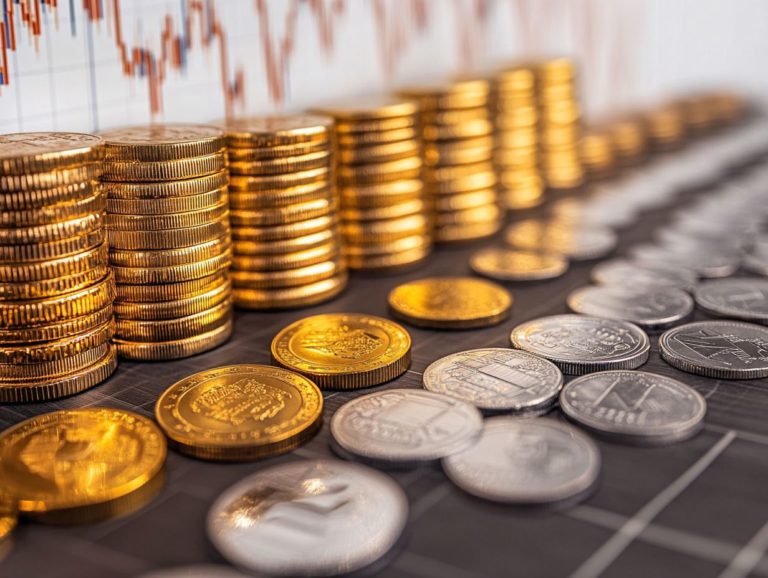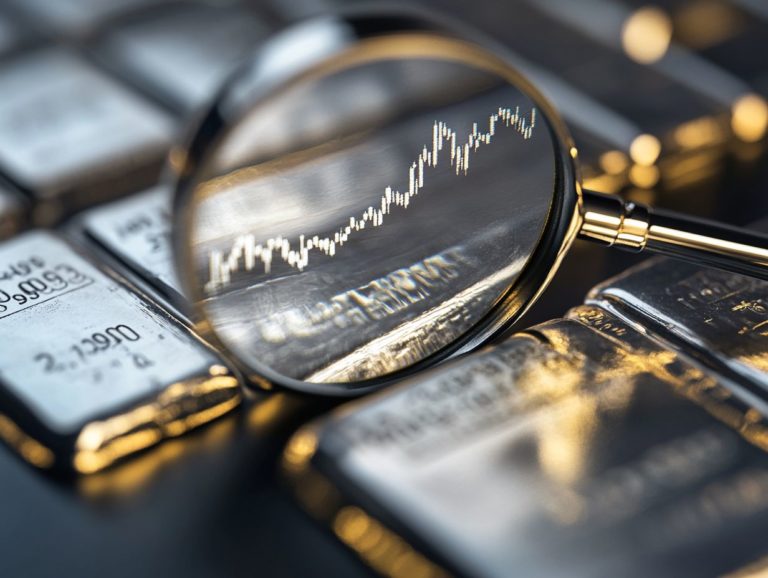Analyzing Historical Gold Price Trends
Gold has long been regarded as a safe-haven investment, particularly in times of uncertainty. Grasping the factors that influence gold prices is crucial.
This exploration delves into key elements such as global economic conditions, inflation, interest rates, and geopolitical events that sway gold’s value. You ll find an analysis of historical price trends, an interpretation of price data, and insights from experts forecasting future movements in gold prices.
Join in as we unravel the intricacies of this timeless investment, equipping you with the knowledge to make informed decisions.
Contents
- Key Takeaways:
- What Drives Gold Prices?
- Historical Gold Price Trends
- Interpreting Gold Price Data
- Predicting Future Gold Price Trends
- Frequently Asked Questions
- What is the importance of analyzing historical gold price trends?
- Where can I find reliable data for analyzing historical gold price trends?
- How far back should I look when analyzing historical gold price trends?
- What are some common factors that affect historical gold prices?
- Can historical gold price trends be used to forecast future prices?
- Are there any risks associated with analyzing historical gold price trends?
Key Takeaways:

- Gold prices are affected by global economic conditions, inflation, interest rates, and political events.
- Historical gold price trends reveal patterns that help predict future movements.
- Using different methods to analyze gold price data can assist in making smart investment choices.
Overview of Gold as an Investment
Gold has long been viewed as a reliable investment, especially in times of economic uncertainty, financial crises, and inflation. It s a precious metal that serves as a store of value. In recent years, as inflation trends and geopolitical tensions have intensified, many investors like yourself have turned to gold as a safe haven asset.
You recognize that gold can help diversify your investment portfolio and mitigate risk amidst fluctuating market conditions and surging asset prices. This overview will delve into the key reasons why gold continues to stand out as a preferred investment option.
The allure of this precious metal becomes evident when you consider its proven resilience during turbulent times. It often outperforms other asset classes like stocks and bonds. Gold’s performance during historical economic downturns illustrates its ability to maintain value when traditional investments stumble.
As a crucial hedge against inflation, gold not only offers potential capital appreciation (increase in value) but also serves as a safeguard against the diminishing purchasing power of fiat currencies. Gold mining companies also significantly influence this ecosystem, impacting gold prices with their production levels and cost structures.
For those like you who seek liquidity and diversification, gold exchange-traded funds (ETFs) present an appealing option. They provide easy access to gold investments without the hassle of physical storage, making them attractive to a broader range of investors.
What Drives Gold Prices?
Several key factors influence gold prices. Understanding these dynamics is important. You’ll want to consider global market trends, inflation rates, interest rates, and geopolitical tensions each of which can greatly impact investor sentiment and demand for gold.
These elements don t just affect physical gold prices; they also play a significant role in the performance of gold mining companies and gold ETFs. As you refine your investment strategy in precious metals, recognizing the interplay of these factors becomes essential.
Global Economic Conditions
Global economic conditions significantly impact gold prices, as they directly shape inflation rates, investor behavior, and overarching market trends. This influence becomes especially pronounced during financial crises when uncertainty prompts investors to flock to gold as a safe haven asset.
When recession looms, inflation often follows suit, compelling investors to seek refuge in tangible assets like gold. Consider the 1970s; high inflation rates triggered by oil crises and geopolitical tensions sent gold prices soaring as individuals rushed to protect their wealth.
A similar scenario unfolded during the Great Recession of 2008. As central banks rolled out measures to stimulate struggling economies, inflation fears escalated, leading to a significant uptick in gold investments.
This historical perspective underscores how fluctuations in the economy can create a ripple effect, impacting both inflation and, in turn, the value of gold.
Inflation and Interest Rates

Inflation and interest rates wield considerable influence over gold prices. When inflation rises, you may find yourself drawn to gold as a safeguard against currency devaluation.
Opportunity cost is the potential benefit you miss out on when choosing one investment over another. Simultaneously, shifting interest rates can impact the opportunity cost of holding physical gold compared to interest-bearing assets.
As inflation escalates, the purchasing power of your money diminishes. This prompts many to turn to gold a tangible asset known for its historical value retention.
When interest rates climb, the appeal of interest-bearing investments becomes more compelling. This shift can render gold less attractive since it doesn t generate yield.
For a vivid example, think back to the 2008 financial crisis. In times of economic uncertainty, when interest rates are low and inflation is high, you might see a surge in gold acquisitions, which drives its price upward.
Conversely, if interest rates increase significantly, you could witness a dip in gold demand. Investors may gravitate toward savings accounts or bonds that offer more enticing returns.
These dynamics show how market participants evaluate and respond to economic indicators. Ultimately, this shapes their investment strategies.
Political and Geopolitical Events
Political and geopolitical events, like crises, conflicts, and shifts in government policy, can significantly influence gold prices. These events often usher in a wave of uncertainty and volatility in financial markets.
This volatility prompts you to seek the stability and reliability that gold offers as an investment. For instance, during the 2008 financial crisis, as fears of economic collapse surged, investors flocked to gold, pushing its prices to record highs.
Similarly, tensions in the Middle East, such as the Iraq War, have historically triggered spikes in gold prices. These spikes are fueled by heightened fears of instability in that region.
By recognizing these patterns, you can strategically weave gold into your investment portfolio. This can be a hedge against political instability and inflationary pressures.
Understanding these historical precedents enhances your risk management strategies and opens up opportunities for capitalizing on potential price surges during turbulent times.
Historical Gold Price Trends
When you examine historical gold price trends, you’ll uncover significant fluctuations driven by a range of economic and geopolitical factors over the decades.
Key periods stand out, such as the tumultuous 1970s and the collapse of the Bretton Woods system. The more recent financial crises have also profoundly shaped investor behavior.
These events have influenced market trends in precious metals, highlighting the complex dynamics at play in this enduring asset class.
Key Patterns and Fluctuations
Identifying key patterns and fluctuations in gold prices over time allows you to grasp the underlying market trends. This knowledge can significantly inform your investment decisions, particularly during periods of economic instability or rising inflation.
Historically, gold has earned its reputation as a safe haven asset, especially amidst geopolitical turmoil or financial crises. For example, during the 2008 financial crisis, gold prices skyrocketed from around $800 per ounce to over $1,200.
On the flip side, between 2011 and 2015, you would have observed a notable decline in gold prices. They plummeted from roughly $1,900 to about $1,050.
This drop was largely due to a strengthening U.S. dollar and rising interest rates, which made non-yielding assets less appealing.
By understanding these cycles, you can enhance your ability to make informed decisions regarding your portfolio. This will also help you refine your risk management strategies.
Interpreting Gold Price Data

Interpreting gold price data effectively demands a sophisticated blend of analytical methods and tools. This approach can unveil market conditions and enable you to make informed decisions about your gold investments.
By adapting your strategies in response to shifting trends, you can position yourself for success in the ever-evolving landscape of gold trading.
Analysis Methods and Tools
You can utilize a variety of analysis methods and tools to interpret gold price data, combining both technical indicators and fundamental analysis techniques to gain valuable insights into market conditions and potential future movements.
Among these methods, moving averages stand out as a favored technical tool, helping to smooth out price fluctuations and identify overarching trends over specified periods. Trend lines, elegantly drawn on charts, allow you to visualize potential support and resistance levels, guiding you to optimal entry and exit points.
Sentiment analysis further enriches your understanding by gauging the broader market psyche, unveiling how news and public opinion can sway trading behavior. By integrating these approaches, you position yourself to better anticipate market shifts, enableing you to make informed decisions that align seamlessly with your investment strategies.
Predicting Future Gold Price Trends
Predicting future gold price trends requires a keen analysis of market conditions, as well as synthesizing expert opinions and forecasts. By doing so, you can gain valuable insights into potential price movements, enabling you to adjust your investment strategies with confidence and precision.
Expert Opinions and Forecasts
Expert opinions and forecasts on future gold price trends are invaluable for you as an investor seeking to make informed decisions based on expected market conditions and broader economic factors.
These insights are drawn from a multitude of reputable sources, including esteemed financial analysts, industry reports, and market research firms. Each employs unique methodologies whether it’s technical analysis, fundamental analysis, or sentiment analysis to derive their conclusions. By examining historical price movements, keeping an eye on macroeconomic indicators like inflation rates, and evaluating geopolitical events, experts offer projections that can profoundly impact your investment strategies.
You can harness these professional insights to identify emerging trends, assess potential risks, and time your gold investments more effectively, ultimately boosting your chances of success in a fluctuating market.
Frequently Asked Questions

What is the importance of analyzing historical gold price trends?
Analyzing historical gold price trends can provide valuable insights for investors, traders, and economists. It can help predict future price movements, identify market trends, and inform investment decisions.
Where can I find reliable data for analyzing historical gold price trends?
There are several reputable sources for historical gold price data, including government agencies, commodity exchanges, and financial data providers. Online databases and charts are also available for free or for a subscription fee.
How far back should I look when analyzing historical gold price trends?
The time period for analyzing historical gold price trends will depend on your specific goals and needs. Some may look at data for the past year, while others may go back decades or even centuries. It’s important to consider the overall trend and not just short-term fluctuations.
What are some common factors that affect historical gold prices?
Historical gold prices can be influenced by a variety of factors, such as economic and political events, supply and demand, inflation, interest rates, and currency fluctuations. It’s important to consider all of these factors when analyzing price trends.
Can historical gold price trends be used to forecast future prices?
While historical data can provide insights and patterns, it should not be solely relied upon for predicting future gold prices. Other factors and market conditions should also be taken into account for a more accurate forecast.
Are there any risks associated with analyzing historical gold price trends?
There are always risks involved with any type of investment. It’s important to remember that past performance does not guarantee future results and to use historical gold price trends as just one tool in your overall analysis and decision-making process.














